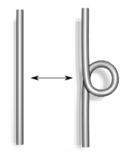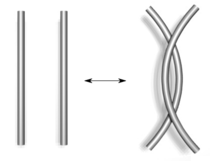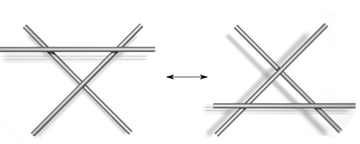Reidemeister movements
 |

|
| Type I. | Type II |

|
|
| Type III | |
In knot theory , a branch of topology , three local movements of knot diagrams are called Reidemeister movements , named after Kurt Reidemeister . Two knot diagrams represent the same (tame) knot if and when they can be converted into one another by a sequence of Reidemeister movements. The same statement applies to interlinking diagrams (multiple components). The three Reidemeister movements correspond locally to the movements shown on the right, the rest of the diagram remains unchanged. Planar isotopies of the diagram are also permitted.
Knot invariants are defined in the so-called combinatorial knot theory by invariants of knot diagrams. In order to prove that it really is a knot invariant, it is sufficient to check the invariance under Reidemeister movements.
They were found independently by James W. Alexander and Garland Briggs.
literature
- Kurt Reidemeister, Elementary Justification of Knot Theory , Abh. Math. Sem. Univ. Hamburg 5 (1927): 24-32, doi : 10.1007 / BF02952507 , MR 3069462
- James W. Alexander ; GB Briggs, On types of knotted curves. Ann. of Math. (2) 28 (1926/27), no. 1-4, 562-586.
- Burde, Gerhard; Zieschang, Heiner. Knots. Second edition. de Gruyter Studies in Mathematics, 5. Walter de Gruyter & Co., Berlin, 2003. xii + 559 pp. ISBN 3-11-017005-1